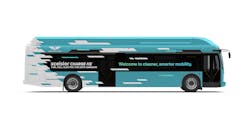Transit is a critical factor in the accessibility of economic and social opportunities for people who do not have access to a personal vehicle. With these services alone, transit has earned its keep as one of the greatest equalizers in society. However, as the world continues to evolve, the transit industry has an enormous opportunity to extend its reach beyond taking people from one place to another and become a solution to one of the greatest threats to communities in today’s world: resilience.
Energy is a Scarce Resource
All over the news, resilience is one of today’s hottest topics. From wildfires to hurricanes to extreme temperatures to floods, communities around the world have experienced situations in recent years in which their resilience has been tested.
During these events, energy becomes a scarce resource. Utility lines are ripped out by strong winds or the grid gets overloaded by a high demand for air conditioning or heating, and thousands, sometimes millions, of people may be left without energy. In the best-case scenario, people are left without energy for a few hours, and it is an inconvenience. In the worst-case scenario, people may be left without energy for days during inclement weather, and it can be a matter of life and death.
In 2021, three severe winter storms left 4.5 million homes and businesses without power during below-freezing temperatures in Texas. At least 246 people died during the power outages with some sources putting the number as high as 814 deaths. That same year, Hurricane Ida caused more than a million people to lose power. During the aftermath of the hurricane, an excessive heat advisory was issued. Despite efforts to evacuate residents to state shelters, 12 people died from heat-related causes from the power outage. To be truly resilient during these situations, communities need to develop decentralized energy solutions that can keep people comfortable and safe and prevent further tragedies.
This is where vehicle-to-grid (V2G) and vehicle-to-everything (V2X) come into play. When most people think about an electric vehicle, they think of a vehicle plugging into a charger and taking energy from the grid. V2G and V2X challenge this idea. With V2G and V2X, the vehicle could actually give energy to a building, another vehicle or return it to the grid. This emerging concept would allow vehicles to be a potential solution to stabilize the grid during natural disasters. On a small scale, your vehicle could be your source of energy for several hours during a power outage. On a large scale, V2G and V2X could be a game changer for an entire community.
Transit is the Resilience Solution We’ve Been Looking For
How does transit fit into this problem? Well, many transit agencies across the U.S. have committed to converting their vehicle fleets to fully zero-emission vehicles by 2040. Some agencies have even taken a more ambitious approach and plan to have a fully electric fleet by 2030 or sooner. This transition offers a tremendous opportunity to improve resilience around the country.
The battery-electric buses (BEBs) that transit agencies use have batteries that can store significantly more energy than a personal vehicle, which means that BEBs have more potential to deliver the larger-scale benefits of V2G and V2X. Currently, a fleet of 30 BEBs has the battery capacity to power an average hospital for a full day. BEB manufacturers are constantly working to make batteries with even more capacity and this number is expected to grow in the future.
Many people may think about this concept and wonder if transit fleets are the right vehicles to provide this service. Many transit vehicles are in service more than 14 hours a day and do not have a lot of downtime compared to other types of fleets. School buses, for example, only run in the mornings and afternoons and even have multiple months each year where they don’t run at all when school is out of session. While school buses and other fleets may be part of the solution too, transit vehicles have a special purpose in the greater V2G and V2X framework.
During natural disasters, transit agencies help people evacuate and get to a safer place. That means that transit vehicles are likely already onsite at evacuation centers, giving transit vehicles the perfect opportunity to use V2X capabilities to provide energy to the evacuation center and keep people safe and comfortable.
Even during situations that don’t require a full-scale evacuation, transit buses still have the potential to provide this incredibly important service. Bus service is often used as an indicator of whether school and even work is canceled during inclement weather. If transit can’t run, that’s usually a good indicator the city will be shut down for the day. While buses are grounded during these events, they could be supplying energy back to the grid to help utility companies handle the influx of demand for energy.
V2G and V2X are not exclusive to BEBs though. Or at least not for very long. The Mobility House, in partnership with New Flyer, the Center for Transportation and the Environment (CTE) and AC Transit, is already leading the charge (pun intended) on one of the biggest innovations in the V2G and V2X space: unlocking the potential of hydrogen fuel cell technology for V2G and V2X.
Hydrogen fuel cell technology is one of the latest innovations in the clean transportation space. It uses hydrogen and oxygen to generate energy to power vehicles. This new technology creates the potential for a continuous energy source that could provide energy to a community during a time of need. The Mobility House is working with New Flyer to create the first ever hydrogen fuel cell transit bus that will give energy from hydrogen fuel back to a building. This will unlock the potential for transit agencies to become the resilience solution that the world has been searching for.
A Safer Future for Communities
Transit agencies have always and will always serve a critical role in their communities. The transition to zero-emission vehicles and emergence of V2G and V2X add yet another way transit agencies can be there for their communities when they need support the most. This exciting opportunity demonstrates why transit is so important to the world, as it gives us the opportunity to advance – as individuals, as a community and as a society.
--------
Dayna Wasley is the North American transit business development manager at The Mobility House.





